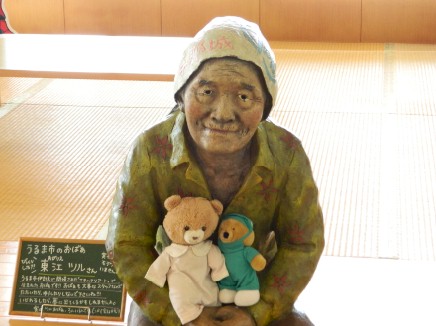
At the foot of the mountain upon which is located the Katsuren Castle there's a small museum. If you weren't looking for it you'd likely drive right past it without noticing. I noticed, thanks to my friend, Michael Lynch, who was out exploring with me this day.
Thursday, March 21, 2017
|
Keywords for Understanding the Gusuku Period
Beyond helping us in understanding the origins of the Gusuku Period, five important keywords help illuminate the period. These include ishinabe [stone cooking pots]; kamuiyaki [lit. tortoise pottery, i.e., gray stoneware]; gusuku earthenware [gusuku doki]; tekki [ironware]; and chūgokusei jiki [Chinese porcelain]. In the early Gusuku Period, ishinabe, or stone cooking pots, made from talc stone mined on the Nishisonogi Peninsula in Nagasaki Prefecture (Kyushu) and used to cook grain, were brought south into the Ryukyuan archipelago. Most frequently found in western Japan, these pots have been found in sites from the Kantō region in eastern Japan to Hateruma Island, southernmost in the archipelago. Kamuiyaki, or gray stoneware, was produced at the ancient kilns excavated on Tokunoshima, in the Amami island group. Frequently consisting of storage containers characteristic of agricultural societies, this type of pottery was of a quality similar to Japanese sue ware and is found throughout the entire Ryukyuan archipelago from Amami to Yaeyama. Gusuku doki, a type of earthenware that mimics the appearance of ishinabe, has the wide, shallow profile characteristic of earthenware produced in the archipelago during its agricultural period. These wares were widely distributed and commonly used, and the quantities unearthed at archaeological sites dating to the early Gusuku Period serve to convey an idea of the progress achieved by this agricultural society. Simultaneously, numerous ironware products such as small weapons and farming tools not produced in the archipelago were also in circulation. The widespread use of ishinabe, kamuiyaki, gusuku earthenware, and ironware items, as well as the comings and goings of the people who brought them in, also helped ensure the spread of various farming techniques. Together these phenomena are held to be the primary forces in the formation of the Gusuku Period, with its agriculture-based hierarchical society led by powerful aji. The final keyword may be the most important in capturing the essence of the Gusuku Period. Chinese porcelain (especially tamabuchi-style white porcelain, thought to have been used as dishes, has been found in early Gusuku Period sites alongside the ishinabe, kamuiyaki, gusuku earthenware, and ironware discussed previously. This porcelain entered the islands after the twelfth century, so Okinawa’s archaeological community has begun to accept that the origin of the Gusuku Period may be set in the twelfth century. However, some scholars have proposed that this date must be moved back to reflect the entry of ishinabe into the archipelago in the eleventh century; the exact period of the arrival of ishinabe remains a topic of hot debate. Because the Chinese porcelain found at excavations is always found together with ishinabe, it probably did not come directly from China, but instead was brought in via Kyushu. The question that remains is just how it was brought in, and by whom. (Akamine, Mamoru. The Ryukyu Kingdom: Cornerstone of East Asia. University of Hawaii Press) |